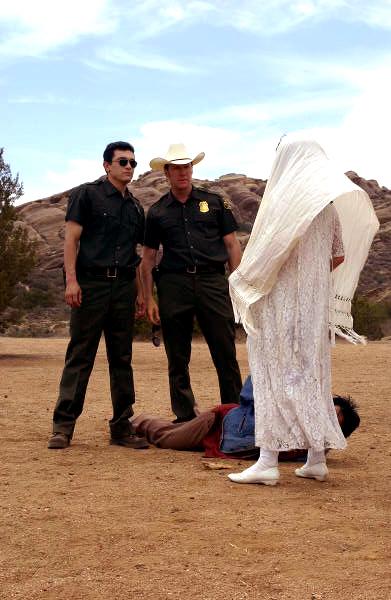La Llorona

'''La Llorona'' is Spanish for "The Crying Woman". Originated in Mexico[citation needed], La Llorona is a popular legend in Spanish-speaking cultures in the colonies of the Americas, with many versions extant. The basic story is that La Llorona was a beautiful woman who killed her children to be with the man that she loved and was subsequently rejected by him. He might have been the children's father who had left their mother for another woman. She drowned the children and then, after being rejected anyway, killed herself. She is doomed to wander, vainly searching for her children for all eternity. Her constant weeping is the reason for her name. In some cases, according to the tale, she will kidnap wandering children or children who misbehave.
Function of the story in society
Typically, the legend serves as a cautionary tale on several levels. Parents will warn their children that bad behavior will cause her to steal them[1] and being outside after dark will result in a visit from the spirit. The tale also warns teenage girls not to be enticed by status, wealth, material goods, or by men making declarations of love or any promises too good to be true. It also cautions them not to express their sexual desires.[1] Some also believe that those who hear the wails of La Llorona are marked for death, similar to the Gaelic banshee legend. Additionally, the tale is a Mexican, Central and South American cultural symbol that models negative and despised feminine sexuality, where La Llorona is the archetypal evil woman condemned to eternally suffer and weep for violating her role as a wife and a mother. She is a failed woman because she has failed at motherhood. She is said to cry "Aaaay, mis hijos!" which translates to "O-h-h-h, my children!" The tale serves to shape Mexican and Latin women's conduct by prescribing an idealized version of motherhood.[2]
Comparisons to other folktales
La Llorona bears a resemblance to the ancient Greek tale of the demonic demigodess Lamia who had an affair with Zeus. Hera, Zeus' wife, learned of the affair. Hera then forced Zeus to give up the relationship and punished Lamia by forcing her to eat her own children. Out of jealousy over the loss of her own children, Lamia preys upon human children and devours them if she catches them.[3][4][5]
In Greek mythology, Medea killed the two children fathered by Jason (one of the Argonauts) after he left her for another woman.
Local Aztec folklore possibly influenced the legend; the goddess Cihuacoatl or Coatlicue was said to have appeared shortly prior to the invasion of Mexico by Hernán Cortés, weeping for her lost children, an omen of the fall of the Aztec empire.
La Llorona is also sometimes identified with La Malinche, the Native American woman who served as Cortés' interpreter and who some say betrayed Mexico to the Spanish conquistadors. In one folk story of La Malinche, she becomes Cortés' mistress and bore him a child, only to be abandoned so that he could marry a Spanish lady (though no evidence exists that La Malinche killed her children). Aztec pride drove La Malinche to acts of vengeance. In this context, the tale compares the Spanish invasion of Mexico and the demise of indigenous culture after the conquest with La Llorona's loss.
See also
- Banshee
- Crybaby Bridge Bridges where the cries of drowned babies allegedly can be heard.
- Kuchisake-onna
- Näcken
- Niobe from Greek Mythology
- Rusalka
- White Lady (ghost)
References
- ^ a b de Jesús Hernández-Gutiérrez, Manuel (1997). Literatura Chicana, 1965-1995: An Anthology in Spanish, English, and Caló. Taylor and Francis. p. 93. ISBN 0815320779.
{{cite book}}:|access-date=requires|url=(help); Unknown parameter|coauthors=ignored (|author=suggested) (help) - ^ Pierrette Hondagneu-Sotelo and Ernestine Avila, "I'm Here, but I'm There: The Meanings of Latina Transnational Motherhood"
- ^ Theoi Project: "Lamia"
- ^ Aristophanes, The Wasps, 1177.
- ^ Aristophanes, Peace
- Perez, Domino Renee, There Was a Woman: La Llorona from Folklore to Popular Culture
- Mathews, Holly F. 1992. The directive force of morality tales in a Mexican community. In Human motives and cultural models, edited by R.G.D'Andrade and C. Strauss, 127-62. New York: Cambridge University Press.
External links
- The New Mexican La Llorona
- Handbook of Texas Online A summary of the tale.
- La Llorona Piano Solo A programmatic work depicting The Legend of La Llorona. An example of uses within society.
- Documentary Film of La Llorona Videoblog of many videos of La Llorona and paranormal activity.
